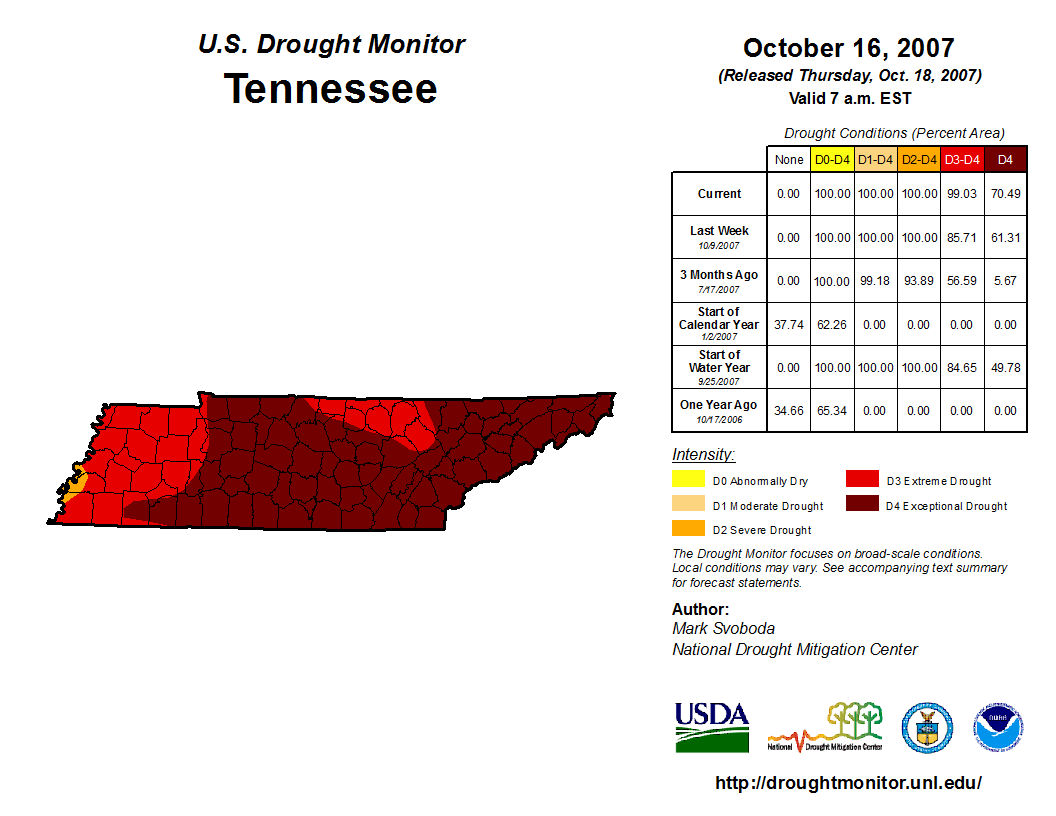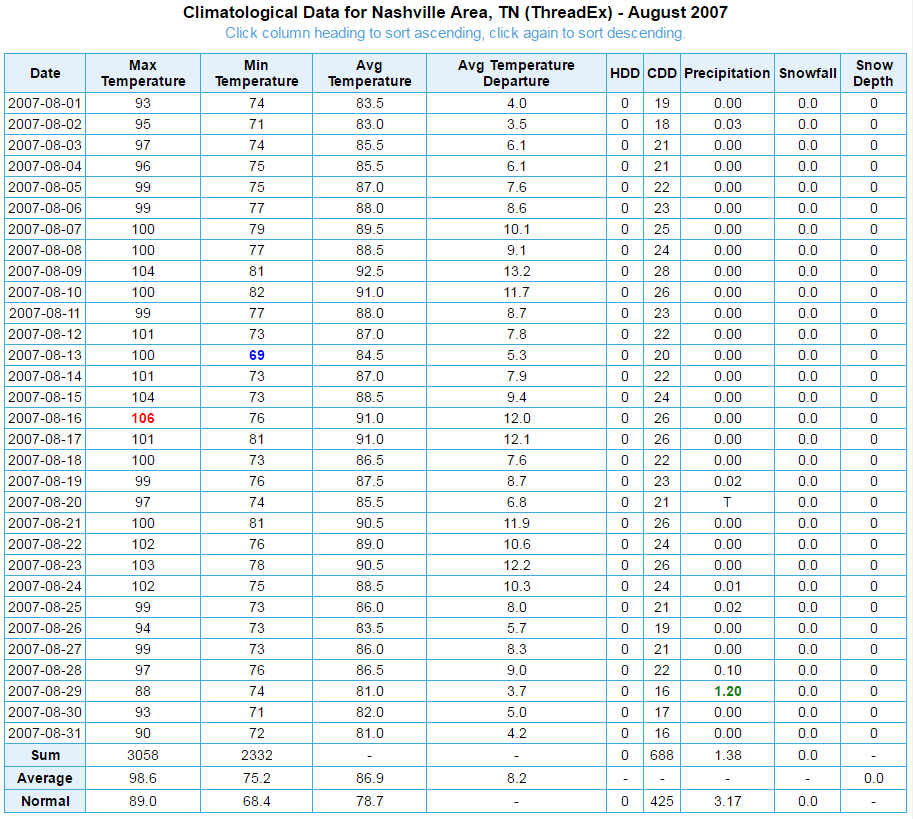
| Overview | |
|
From 2007 Storm Data publication: The severe drought of 2007 began in March 2007, but was exascerabted by a hard freeze in early April which killed or damaged many outdoor plants. Effects of the drought began being felt in May by agriculture interests. The quality of hay was poorer, and yield was down by as much as 60 to 70 percent. There were 14 consecutive days in May, specifically from May 17-30, when no rain fell in Nashville. There was a trace of rain on May 31. May had 3.30 inches of rain which was 1.77 inches below normal. The Tennessee State Department of Agriculture estimated the crop loss in the 100's of millions of dollars. The drought was in full swing by Mid-May, and by the end of June, many locations were running at least 10 inches below normal rainfall. Since the drought continued into the Fall of 2007, agriculture suffered greatly - in particular farmers and nursery owners, which were the hardest hit economically. Cherry Creek Nursery in Cookeville saw 40% of trees planted this spring die from lack of water. Cherry Creek Nursery lost one million dollars worth of Japanese maple trees to the late spring hard freeze. One vegetable farmer in Ridgetop, TN was running pumps to move water to his fields for 16-hour days, at a cost of $300-500 a week. Corn, soy, and tobacco yields were very low and of poor quality. Many farmers bought hay from other farmers at 3 times the normal price. Corn production was down 50 percent in Sumner County. Forage hay was 1/3 of what it should be. The poor hay production affected the state's livestock sector, with poor pasture conditions and reduced hay production causing farmers to sell off part of their herds.State Department of Agricultural Commissioner Ken Givens said hay production was down 50-80 percent, and three-fourths of the state's pastures last week were rated in bad condition. Some hard hit crops were winter wheat and hay, soybeans and tobacco. Winter wheat yield is projected to be one half of last year's record yield, which brought in $42.6 million. Commercial wineries had to rely on imported grapes. About 30 commercial wineries produce between $7 and $8 million of wine each year, but the University of Tennessee's plant sciences professor David Lockwood expected an 80% crop loss in 2007 due to the drought. Hay that normally sells for $60 to $70 a ton, now sell $100-$150 a ton. Hay production was off 60% in Putnam County. Farmers are selling off their herd because of the high cost for hay. Tobacco farmers in Macon County were hit hard. A typical crop may bring in $15-million in a good year, but in 2007 the tobacco crop was expected to bring in less than $10 million. Perhaps as much as 1000 acres of the county's 4,500 acres of tobacco were not cultivated due to the poor quality of the tobacco. Macon County was approved to conduct an Emergency Conservation Program (ECP) signup for drought relief. The drought was even hard on Christmas tree growers. As one example, the Volunteer Tree Farm in Lebanon lost about 5,000 trees. Tennessee crop losses in 2007 likely totaled $750 million because of the drought. Agricultural losses in some counties, such as Coffee County, reached $10 million alone. Cotton, tobacco, soybean, and hay yield were down 38%-48% from 2006. On June 15, all Tennessee Counties were designated primary disaster areas because of losses caused by the drought, which allowed qualified farm operators to be eligible for low-interest emergency loans. The impact of the drought continued through the Summer of 2007. Governor Phil Bredesen requested federal disaster drought assistance aid for farmers across all 95 counties in Tennessee on July 5, 2007. The request was approved by the USDA on July 31. The lack of rainfall made it difficult for TVA to keep river reservoirs full, and as a result, hydroelectric power production was cut by 50 percent. As an example the Tennessee Valley Authority (TVA) average system inflow above Chickamauga Dam for the week ending July 8 was 4,010 cubic feet per second (cfs). That inflow for the week ending July 8 ranks 105th out of 105 years of record for this time of year. TVA had to purchase electricity from more expensive sources, namely from electric plants that produce electricity from fossil fuels, due to the reduction in hydroelectric power production. Tennessee had 37 drinking water supply systems take voluntary or mandatory conservation measures, such as the Jackson County Utility District, which issued a State of Emergency and water restrictions rules for its customers. Second time violators of these restrictions had their water meter taken out until restrictions were lifted and fines are paid. Another State of Emergency was declared by the Red Boiling Springs Mayor and Water Commissioner on July 17th. In Franklin, 5 homeowners had their water cut off for violating the restrictions. East Fork Utility District Board voted to place mandatory water restrictions for its customers in southeast Overton County, which gets water from the City of Monterey. At one point there were only 140 days of water supply left. A heatwave in August 2007, with high temperatures reaching over 100 degrees, only made conditions worse. School was cancelled in Metro Davidson County because of the high heat, and football games and practices were either delayed or cancelled throughout Middle Tennessee. A newspaper story said that numerous dogs died in Rutherford County because of the heat. Attendance at the Wilson County Fair was even down 12.6% at 366,641 people because of the heat. Effects of the drought continued into Fall 2007 across Middle Tennessee, with area wildlife even affected. According to the Tennessee Wildlife Resource Agency (TWRA), area wildlife were not at the point of starvation, even though their food supply is low. Deer were expected to reduce their reproduction next year and have high fawn mortality due to the drought. Dairy cows in the Cookeville area were producing 20% less milk because of the high temperatures stress on the cows, and because the cows were not eating enough. With many area streams having dried up or running at very low levels because of the drought, fish were stressed by low water flows, high water temperatures and competition for food and space. These conditions caused spawning failures or increased predation on young fish. Birds were also impacted by the drought. Hummingbirds were at feeders because of fewer flowers were available. However, it would take several years of a drought to cause a severe effect on area wildlife. The drought began easing up in the western parts of Middle Tennessee in November and December 2007. The City of Portland in Sumner County lifted water restrictions along with the City of Lafayette. |
| U.S. Drought Monitor on October 16, 2007 at Peak Drought Conditions | |
 |
| August 2007 Surface Observations at Nashville, TN | |
 |